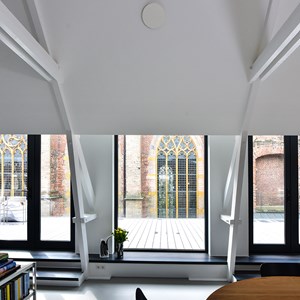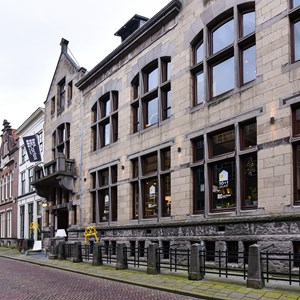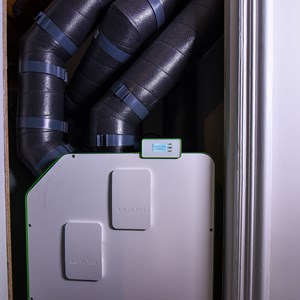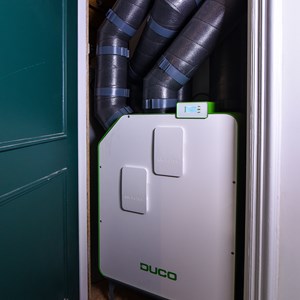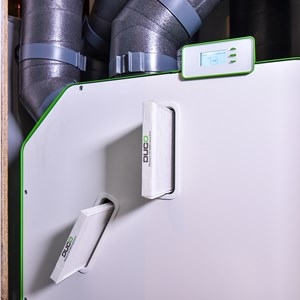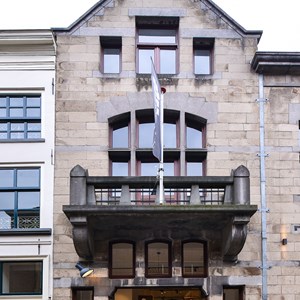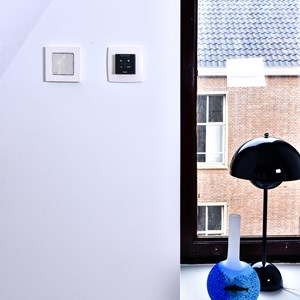On the top floor of this former bank office, the bare attic space was converted into a luxurious living space with attention to a healthy indoor climate.
Carlos in Huis - Deventer (NL)
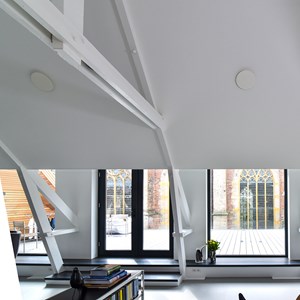
Renovated national monument equipped with DUCO balanced ventilation
The former Salland Bank branch is to be found in the heart of the Dutch city of Deventer. The bank on the Hofstraat stood there neglected for several years. Interior designer Carlos van Dijk spotted this historic building two years ago. He and his wife Thea instantly fell in love with it and turned it into a real gem. The ground floor was to house an immense homeware store. The bare attic space on the upper floor was converted into a luxurious apartment focusing on a healthy indoor climate.
A bank building dating back to 1914 was converted in mid-2018 into a homeware store on the one hand – with over 800 m² of floor space – and a comfortable and energy-neutral apartment on the other. The couple bought this property in Deventer city centre after it had stood empty for five years. Specifically, we are referring to the Carlos in Huis [= Carlos at Home] project, which they moved into in 2018.
On opening the majestic front door, it immediately becomes clear to us: this is a highly individual building with soul. We are currently in the store and it is striking that each room has its own atmosphere and style. The terrazzo floors, traditional panelling, marble counter, etc. are in stark contrast to the contemporary collection of furniture, lighting and accessories. We met the owners Carlos van Dijk and Thea Witteveen on site, where they are happy to tell us more about their apartment located on the attic floor of the listed building.
Protected heritage
‘This structure has never been in residential use’, says Mr van Dijk at the outset. ‘In other words, we had a completely blank canvas. We bought this old bank branch and first spent a year renovating our store. The following year we converted the attic floor. The result is a comfortable and energy-neutral apartment with high-quality finishes.’
‘The opportunity to transform this stunning location into a warm home was sublime,’ the owner continues. ‘The building was graded as a ‘Listed Building’, which meant we were still bound by some restrictions. Accordingly, we opted for double glazing everywhere, except for some windows where high-quality conservation glass had to be used. We worked closely with the Listed Buildings Council before each step and restored the building to its original condition as far as possible.’
Future-proof apartment
Once we were upstairs in the apartment, we became aware of its homeliness. ‘We had a strong preference for natural warm materials such as red cedar, ayous wood and linoleum,’ says Mr van Dijk. ‘We are also energy-conscious: our apartment is ready for the future since this building has no gas supply, relying on district heating instead. What’s more, we opted for solar panels and thorough insulation combined with an effective ventilation system.’
Choice of ventilation system
Richard Geraerts, Sales Manager at DUCO, adds: ‘Historic heritage makes choosing the right ventilation system a challenge, especially when you have to consider aesthetic choices as well. It was not possible to use natural ventilation because of the listed status of the façade. That is why an MVHR system was chosen, namely the DucoBox Energy Premium with two-zone control. This two-zone mechanical ventilation unit with heat recovery differentiates between the living and sleeping areas to deliver good energy performance. This is because the system uses sensors to monitor the occupant’s movements in the home and, as a result, automatically determines when ventilation is needed. This will save you a great deal on your energy costs while contributing towards reducing global CO2 emissions.’
‘An additional benefit is the residents’ acoustic comfort,’ explains Mr Geraerts. Residents do not need to worry about noise. Partly thanks to the integrated 2-zone control, but also to the favourable positioning of the extract units and the use of sound-absorbing material, the air supply is the quietest on the market (55 dB at 325 m³/h).’
Energy savings and improved acoustic comfort are the two benefits that underpin of the zonal ventilation concept. With a 30% lower noise level than a central system and energy savings of up to 40%, zonal ventilation is also a substantial component of an Active House concept.
In fact, the Active House concept requires adequate ventilation via CO2 monitoring across 2 zones, which is effortlessly achievable for the DucoBox Energy Premium.
Appearances matter too
‘From the point of view of my work as an interior designer, aesthetic interest is perhaps the most important factor,’ admits Mr van Dijk. 'For example, we looked for supply vents and extract diffusers that are virtually invisible in the room and discovered that the DucoVent Design AK vents fitted perfectly into this story,’ Ms Witteveen continues. ‘These vents are subtly designed and are suitable for ceiling and wall mounting. Given that our apartment is located in the ridge of the roof, this was the ideal answer.’
In practice
Edwin Spijker, Netherlands Installation area manager at DUCO, adds: ‘In modern apartments like Carlos and Thea’s, attention is being paid increasingly to airtight insulation. After all, savings can be achieved on energy bills once the home has been insulated airtight. However, the fresh air needs to come from somewhere but preferably not via uncontrolled air flow which, after all, gives rise to heat losses.’
‘This is not the case with mechanical ventilation with heat recovery,’ continued Mr Spijker. ‘The unit supplies fresh air to and extracts stale air from the home mechanically using built-in fans. Existing heat is put to the best possible use: heat is recovered from the exhaust air and transferred to the outdoor air. The implementation of this ventilation system guarantees a healthy indoor climate and comfort for the occupants.’
This is because the DucoBox Energy Premium is equipped with temperature sensors that play a key role in the control software. The aim of this is to keep the indoor temperature of the home as stable as possible, such that the heating system only has to run when it is really needed. This provides absolute added value in any home, as well as constituting an important part of the Active House concept.
This is how DUCO endorses the importance of sustainable techniques for the future.
